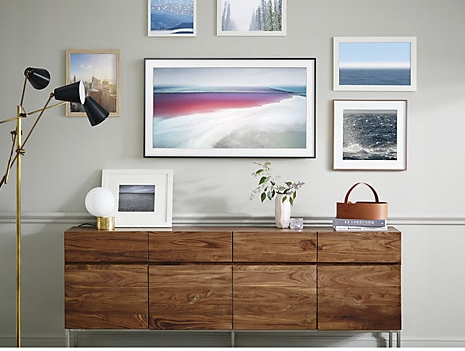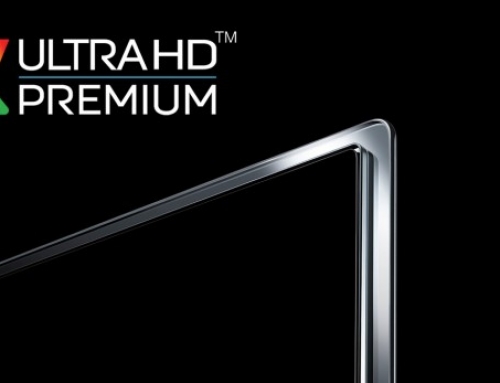The limit to which you can increase the angular resolution by stepping back depends on your visual acuity (ie how good is your eyesight). At some point, your eyes are not good enough to distinguish all the details. Studies show that someone with 20/20 vision can distinguish something 1/60 of a degree apart. This means 60 pixels per degree or 32 degrees for a 1080p television. 4k UHD TVs double that to 64 degrees. Keep in mind that you can see a single pixel from further away (depending on its contrast with the rest of the picture).
For 4k, this distance is often too close for most people. This is because 1080p was designed around the field of view logic above. It is the cutting point at which both the optimal field of view and 60 pixels per degree meet. For lower resolutions, it meant sitting a bit further than preferable to not notice the pixels, 4k resolutions and higher give you a lot more freedom. Because of this, visual acuity isn’t really the best way to find the right distance anymore, and it should instead be used as a way to figure out the closest point you can sit to a TV without hitting its resolution limitation.
The chart also shows that a 4k upgrade is not worth it if you are sitting more than 6′ away and have a 50″ TV. Your eyes won’t be able to tell the difference. Ultra HD resolution actually only really makes sense if you want a really big screen and plan on sitting closer to it.
TV Size…….Optimal Distance (HD)……….Optimal Distance (UHD 4k)
40″………….5.1′ (1.56 m)……………………….2.3′ (0.71 m)
50″………….6.3′ (1.93 m)……………………….2.9′ (0.89 m)
55″………….7′ (2.14 m)………………………….3.2′ (0.98 m)
60″………….7.6′ (2.32 m)……………………….3.8′ (1.16 m)
65″………….8.2′ (2.5 m)…………………………4.1′ (1.25 m)
70″………….8.9′ (2.72 m)……………………….4.4′ (1.35 m)
How do you interpret the chart?
There are a few ways to read the chart. For example, let’s say that you have a 50″ television. Start at the bottom of the chart at 50″. Up to 3′, you are below the blue line. This means you can see the pixels of an Ultra HD resolution. If you go back a bit (up in the chart), between 3′ and 7′, an Ultra HD resolution does not matter anymore because you cannot see the extra pixels anyway. However, you are still too close for a 1080p resolution (it will not appear perfect). Above 7′, the perceived quality will start to decrease for 1080p because your eye will not see all the details. You would notice the difference though, it if was 720p. For more than 10′, it does not matter if it is a 720p or 1080p HDTV, your eyes are not good enough to see the difference. You will still see the difference for a standard resolution video, though, up to a distance of 18′. To summarise, you can see the pixels if you are below the line, but not when you are above.
To use your TV’s resolution to its maximum, you want to be exactly on the line for your TV dimensions and media resolution.
3 Compression Artifacts
This takes into account perfect resolution, which is never the case in real life. Even if you are watching a HD channel presented in high resolution, there will be some artifacts due to the compression algorithm. Artifacts can appear in multiple forms like noise, blurs or a pixelated image (see the picture to the right). You will be able to see artifacts from farther away, so consider the above numbers as being for perfect 1080p media. The numbers show the minimum distance at which you start losing the advantage of the resolution. However, as 4k TVs are the most common, we recommend using our FOV chart as angular resolution is almost a non-issue with UHD content.
4 Budget
You are probably now thinking something along the lines of “My couch is 10′ away from my TV, which according to the chart means I need a 75 inch TV. This is insane!”. Yes, if you want to take advantage of the full capacity of higher resolutions, this is the ideal size. This brings us to another factor for most people: the budget.
Historically, the price of a TV has been exponential to its size, and large TVs were for very large budgets! However, in recent times TV prices have dropped dramatically at the larger size ranges, and some 75” TVs are now actually quite affordable, and consistent with prices of 55” a few years ago. We have found that over the last few years, we have been installing more and more TVs over 55” in size. So if your room is big enough and you want a more immersive experience then go bigger.
Conclusion
We recommend an angle of vision of 30 degrees for a mixed usage. In general, we also recommend getting a 4k TV since 1080p choices have become quite uncommon and lack modern features such as HDR. To easily find out what size you should buy, you can divide your TV viewing distance (in inches) by 1.6 (or use our TV size calculator above) which roughly equals to a 30 degrees angle.







